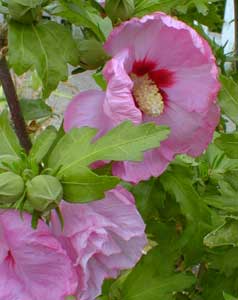
Mythological Associations of
the Rose of Sharon
"Rose of Sharon
You have cried with me
You have lit my darkest moments.
Rose of Sharon
You have walked with me,
You have never left my side."
The flower name Rose of Sharon was borrowed from the the Song of Songs. The species that is today known (especially in America) as Rose of Sharon is Hibiscus syriacus, the variety 'Aphrodite' being shown here at the page-top, & the variety 'Blue Bird' shown in the fourth photo below, in July portraits.
H. syriacus acquired its species name because it was long believed to have originated in Syria, & so it was believed possible that it was the very shrub alluded to in Solomon's erotic Song. However, it is actually an Asiatic species, but was so long gardened in Europe that its origin was for some while forgotten.
Hypericum calycinum or Aaron's Beard is also sometimes called Rose of Sharon, especially in the United Kingdom. The third photo below shows the bright yellow flower of Aaron's Beard in June. But it was the opinion of Linneaus that the Song's specific Rose of Sharon was one or another species of Cistus, the Rock Rose, although I like better the Rock Rose's identification with Jeremiah's Balm of Gilead.
Still others have supposed some type of Crocus, Gladiolus, Narcissus tazetta , or else Tulipa sharonensis, the Sharon Tulip, was the flower Solomon had in mind, among which the Narcissus is frankly most apt to have been the specific plant intended by the ancient author, even though it's not the genus today evoked by the scriptural passages.
Really any of these others, rather than H. syriacus, would be a more likely choice given their actual geographical ranges. Nevertheless, the shrub that is today most strongly identified as the Rose of Sharon is apt to forever remain H. syriacus.
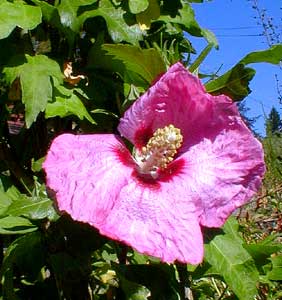 There have been other surmises, but it really doesn't matter since the Rose of Sharon was not so much a specific earthly flower as it was a symbol of the Perfect Bride, & the Perfect Bride symbolized the fruitfulness & beauty of the Earth (or Earthmother) when She was at peace & in harmony with God.
There have been other surmises, but it really doesn't matter since the Rose of Sharon was not so much a specific earthly flower as it was a symbol of the Perfect Bride, & the Perfect Bride symbolized the fruitfulness & beauty of the Earth (or Earthmother) when She was at peace & in harmony with God.As I am very fond of plant folklore, I seriously had to have a Rose of Sharon, aka Shrub Althaea, before which I can meditate upon the rich & sacred lore associated with this name. "Sharon" means "Fruitful," a word that Torah associates with good pasturage for sheep. In much of the ancient Semitic world Sharon was a Goddess epithet. When Isaiah says, "Sharon shall be a fold for sheep" [Isa 65:10], "sheepfold" is in this context a borrowed epithet ordinarily for the Semitic Goddess Anath (in Greek, Astarte) who gave birth to sheep, cattle, & other beasts, after bringing her brother Baal Hadad back from the dead, & laying with Her brother in connubial embrace. So too Solomon's bride was his sister [Song 6:9; Proverbs 7:4; Zohar I:111b, 133a].
Sharon had earlier been an epithet for the Sumerian 250 Ki whom, in pictographs, had the form of a sheepfold enclosure. The Sheepfold Enclosure was not only the fertile field, but also the Womb of the Mother, wherein She protects even the dead. Sumerian Ki as a Sheepfold Enclosure is not so different from the Titaness Gaea depicted as a labyrinth, the Great Mother with rule of Life & of Death, or of Cybele who wore a crown upon her head in the form of a walled city. In spritual thinking, there was no real distinction between the walls of a human city & of a sheepfold enclosure or the labyrinth which were like unto the womb of the Great Mother.
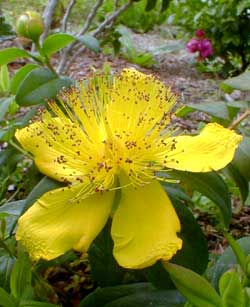 The Philistine Aphrodite called Ashteroth, whose Temple is spoken of by Samuel [1 Sm 31:10], possesses a name that can be translated literally "Sheepfold Enclosure," for sheep were almost always symbolic of the Mother Goddess as flock-defender, fertile Earthmother, & underworld Labyrinth. Ashtaroth can also be a plural meaning "multiple Astartes." In the censorious verse, "They forsook the Lord & served Baalim and Ashtaroth" [Jg 2:13], the meaning would be "gods & goddesses," rivals of Yahweh the Lord.
The Philistine Aphrodite called Ashteroth, whose Temple is spoken of by Samuel [1 Sm 31:10], possesses a name that can be translated literally "Sheepfold Enclosure," for sheep were almost always symbolic of the Mother Goddess as flock-defender, fertile Earthmother, & underworld Labyrinth. Ashtaroth can also be a plural meaning "multiple Astartes." In the censorious verse, "They forsook the Lord & served Baalim and Ashtaroth" [Jg 2:13], the meaning would be "gods & goddesses," rivals of Yahweh the Lord.Yet elsewhere Ashtaroth is not a bad or forbidden thing, as when scripture uses the word specifically to mean "sheepfold enclosure." For instance, we may read how God, "chose David his servant & took him from the sheepfolds; from tending Ashtaroth's young he brought him to be the shepherd of Jacob his people, of Israel his inheritance" [Psalms 78:70-71]. Such Goddess borrowings were effective even among monotheists of this ancient time for two reasons, first because many of the names of God are actually feminine names, such as Sabaoth (like Ashtaroth, a feminine plural); or Eloah, a feminine name of God liked best in the Book of Job, & which also occurs in scripture's oldest poetry [Dt 32:15,17], Eloah being a cooptation of the Ugaritic divine name of Eloh, who is Asherah as bride of El & as genius of Oaks (Elath). Eloah is identified as the Divine Shekhinah of the Targums, the Shekhinah being the female presence of God
By these we can see that it was not essential that God be perceived as male; indeed, although nowhere in scripture is it ever suggested God has a penis, God does have a womb & experiences birthpangs [Gn 49:25; Dt 32:13; Ps 110:3; Isa 42:14; 66:13, 8-10], which among mystics is understood as evidence as the Shekhinah or Divine Presence as definitively female.
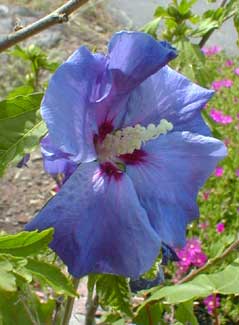 But even if He were male, then the whole community of Israel, or Zion, or Jerusalem are persistantly personified as His Bride. The Jews of Elephantine did not even try to disguise Her as a poetic fancy, & worshipped Her openly as Anath the bride of Yahweh (calling Her Anathyahweh or Anathbethel), preserving an older form of Judaism as practiced when the Temple was in Bethel (Anath's shrine within the Yahweh Temple compound at Bethel has been well documented by archeologists).
But even if He were male, then the whole community of Israel, or Zion, or Jerusalem are persistantly personified as His Bride. The Jews of Elephantine did not even try to disguise Her as a poetic fancy, & worshipped Her openly as Anath the bride of Yahweh (calling Her Anathyahweh or Anathbethel), preserving an older form of Judaism as practiced when the Temple was in Bethel (Anath's shrine within the Yahweh Temple compound at Bethel has been well documented by archeologists).But even if all one wishes to admit to is the "mere" personification as a poetic fancy, we find among the prophets numerous hypostatic presences such as Ninevah who is a speaking presence to the Prophets, the name Ninevah being fully understood to be the Goddess Ninua herself. In the prophetic books we also hear of "Ohola & Oholibah" the sisters whom the Lord desired; or "Samaria & Jerusalem" personified as wayward sisters; or Mother Zion; & so on. When faithful to God, these hypostatic women were God's Brides, & when unfaithful to God, or when like Ninua/Ninevah defeated in battle, they were polluted (menstruant) harlots raped or reviled in their shame.
Much prophetic language plays misogynistic word-games against the Mother Goddess, but not in the Song of Songs, where erotic Goddess imagery is coopted wholesale from a much more ancient Semitic literature, joyfully illuminating the hieros gamos of God & Goddess, King & Queen. This was once a normal part of Judaism & not just "foreign" cult nor even just the province of Jewish mystics. It represented, for millenia, an outright love for the Mother Goddess as fundamental even among Jews, as is made clear by Jeremiah, who was born in the City of Anath, & was castigated by Jewish women for his sorry-ass disdain for the Queen of Heaven [Jr 44:15-28].
The famed "Wine of Sharon" was regarded as Her menstrual blood, which for all its excellence was only half as rich as the flux of Carmel [b. Talmud: Niddah 21a]. The Crimson-spot Rock Rose which can today be seen flourishing on Mount Carmel would seem itself to be spotted with Her very flux. And here again in this talmudic association we see the very ancient tendency to assume two divine sisters, in this case Sharon & Carmel. Sharon was the fertile plain south of Mount Carmel, both of which are personified as menstruant women, which could indicate either a forbidden or "polluted" cultic association, but could as easily indicate the New Moon festivals which were overseen by Jewish women, this being not coincidentally the time of menstruation, hence also the mishnaic regulation that princes rather than the women cook the New Moon feast.
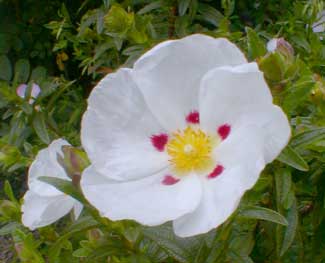 Carmel means "Orchard," from kar meaning either pasturage or a lamb, extending the sheepfold enclosure imagery, but also puns with karmil meaning bright crimson or carmine, hence suggestive of wine as the menstrual flow of the Earthmother, but also a very ancient Divine Name of a generation earlier even than the Titans, the Goddess Kar of Crete having been the inventer of the first human alphabet, & very likely having had the physical form of a divine sheep as did Sumerian Ki & Egyptian Amnet the Hidden One, Great Lady of the Underworld. Underworld associations are likewise rife for the Rose of Sharon, who is explicitely identified as protectress of the dead, for it was Sharon that sang, "My dead bodies shall arise. Awake and sing ye that dwell in the dust" [Isa 26:19; Midrash Tehillim 1:20].
Carmel means "Orchard," from kar meaning either pasturage or a lamb, extending the sheepfold enclosure imagery, but also puns with karmil meaning bright crimson or carmine, hence suggestive of wine as the menstrual flow of the Earthmother, but also a very ancient Divine Name of a generation earlier even than the Titans, the Goddess Kar of Crete having been the inventer of the first human alphabet, & very likely having had the physical form of a divine sheep as did Sumerian Ki & Egyptian Amnet the Hidden One, Great Lady of the Underworld. Underworld associations are likewise rife for the Rose of Sharon, who is explicitely identified as protectress of the dead, for it was Sharon that sang, "My dead bodies shall arise. Awake and sing ye that dwell in the dust" [Isa 26:19; Midrash Tehillim 1:20].It seems no mere marvelous coincidence that one of the Rose of Sharon cultivars in our gardens should have been named 'Aphrodite,' for it is just too apropos to have been accidental. Aphrodite who stepped out of the sea onto the island of Cypros is ultimately just a non-semitic form of "Asherah Who Trod the Sea," as she is called in Ugaritic literature. Aphrodite, too, has her menstrual mythology, for red coral was said to be her solidified menses. It has become traditional to name Rose of Sharon cultivars for goddesses, including 'Diane,' 'Minerva,' & 'Helene.' Even the Greek name for Mallow, Althaea, was mother to one of the Argonauts, a significant figure in the myth of the runner-virgin Atalanta.
Sharon the Rose among kabbalists preserves these most ancient associations, for according to the holy Zohar of Saphed, this very Rose is a symbol of Malkhuth the Lower Shekhinah [Zoh III:121a]. Indeed, the Rose of Sharon sits beside God in Heaven in a throne identical to His [Zoh III:107a]. Or the Rose & the Lily are twin sisters who rule seven mountains [2 Esdra 2:19] & are the source of all joy [Sirach 50:8]. Ah! These associations are so thrilling. The shocking thing is how many deeply religious people can read a work like the Song of Solomon, or the closing Proverbs addressed to the Perfect Woman (who is again the Shekhinah who brings treasures from afar), & yet fail to perceive what mystics so easily perceive, that when we are nearest to God, we are in the loving embrace of a very great Mother.
The twinning of such names as Sharon & Shoshan to identify a single divine figure we find standard in Babylonian & Canaanite literatures, & frequently emulated in scripture. The Goddess is typically alluded to within single couplets with two names at a time, hence Asherah of Canaan is also Elath of Tyre; Babylon's Zarpanitu is also Belit-ili. So too the Rose of Sharon says she is simultaneously Shoshan of the Valley.
Sharon was noted for the beauty of Her hymns to God, for her name is punned with shirah or "song," hence the extended wedding song of Solomon & his Perfect Bride, who is none other than Mother Wisdom, the same as buildeth Her house of seven pillars [Pr 9:1, off which 2 Esdra 2:19 builds].
It is from Her own voice that She sings for Solomon that famous line, "I am a rose of Sharon, I am Shoshan of the valley" [Song 2:1], identifying herself with the ancient Persian Mother Goddess En-susinak, for whom Shoshan is a very direct pun, just as the Great Mother Ninua is often encountered in the writings of the prophets (see especially Zeph 3:2-5 in which she is a deplored harlot for refusing to sleep with Yahweh; or Nahum 2:7-8, 3:4 which describes her as a beautifully endowed harlot, whose priestesses moan like doves & beat their breasts, but who were also amazons who fought in battle [3:13]). And just as Ninua gave her name to the Syrian capital Ninevah, so too Shushan or Susan gave her name to the Persian capital, Susa, home of Queen Esther, but also of the Jewish heroine Susanna.
It is appealing to assume some connection between a Goddess known as the Rose of Sharon, & the Hyksos city of Sharuhen, "The Dwelling Place of Grace (or Pleasure)," a name that could well imply an orgiastic fertility cult. This city was in the Southwest corner of Canaan [Josh 19:6], where the Goddess Anath was paramount. This city was also called Shaaraim [Josh 15:32; 1 Sm 17:52; 1 Chr 4:31], meaning "Two Gates" or "The Double-cleft," alluding to the vagina of the Goddess as a portal into Life (Sharon the Rose), & a portal into Death (Shoshan, the Lily of the Valley). Like Ishtar-Inanna, she is the All Mother with rule of Life & of Death, of the Heights & of the Depths, or like a Sun-mother who goes in & out of the world by means of the davern portal, Queen of Day & of Night.
In Hebrew the Lily of the Valley epithet simultaneously means She is a Swallow or a Mare (sus), as En-Susinak was either a white dove or a mare. We've another Rose of Sharon cultivar, 'Blue Bird,' & I cannot help but think of Zipporah, the wife of Moses whose name indicates a Swallow.
Shushan, as well as the Hittite Cybele, were often symbolized by a dove which in turn symbolized the heavenly descent of the Mother Goddess into the world, in the form of the bird, or of a meteor. Among early Christian gnostics, & even today among mystic Christians, especially within the Eastern orthodoxy, this Dove remains a manifestation of Sophia as Holy Spirit, motherly attribute of the Trinity, so it is by no means Jewish mystics alone who preserve this most ancient love of the Mother.
Elsetimes the Elamite Shushan & her consort were white mare & white stallion. Or from the Hebrew shush, her name meant "to Bloom or Sparkle," as with a celestial aura, or like a flowering meadow or garden. In Akkadian her name can be punned with sasu, "to call," as to call forth Creation, the same as the Cretan Kar whose alphabet was just the first manifestation of a greater Creation. So too the name can be punned with sassuru, a name of Nintu (Ninua) as birth-goddess, or a class of fourteen subsidiary birthing goddesses. The Persian meaning of sus is "Origination" because Shushan was the foundation of the universe, just as Malkhuth the Lower Shekhinah, aka the Rose of Sharon, is the foundation of the Sephiroth Tree of Kabbalah.